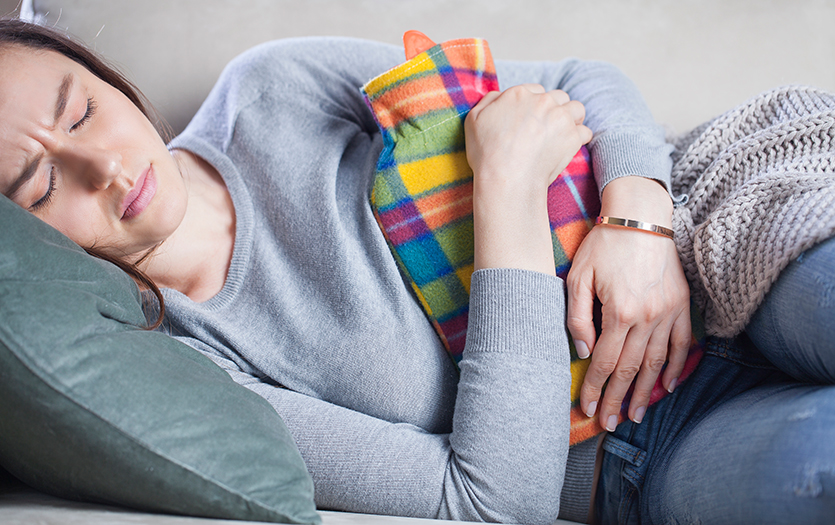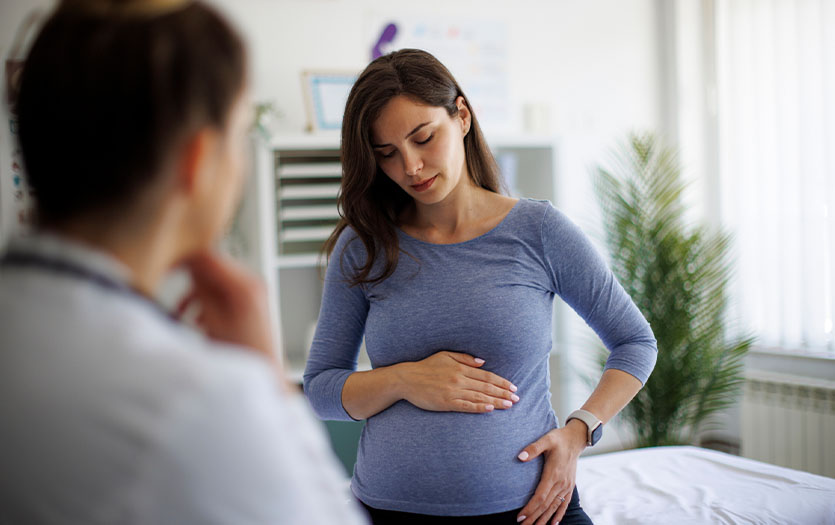.jpg)
As a parent, it’s hard to know if your child’s cough or sore throat is due to the common cold, a symptom of seasonal allergies or a warning sign of something more serious. To help parents decipher between ailments, Reshma Khatri, MD, PPG – Pediatrics, offered a quick guide to some common pediatric illnesses, including their symptoms, risks and ways to identify what has your little one under the weather.
Respiratory Syncytial Virus (RSV)
Respiratory Syncytial Virus (RSV) is a common and very contagious viral infection that affects the respiratory tract, upper airways and lungs. While RSV can affect anyone at any age, it is most common in children younger than 5, with babies being most at risk for serious complications especially if premature or born with heart or lung disease.
How can RSV be contracted?
RSV spreads through the air when the patient coughs or sneezes and through direct contact like touching the face of a child with RSV.
What are the symptoms of an RSV infection?
RSV can cause cold-like symptoms, including a cough with mucus and nasal congestion, but also present with the following:
- Wheezing (heard on an exam by a physician)
- Difficulty breathing (pulling in ribs) or apnea
- Refusal to breastfeed or bottle-feed due to the above
- Signs of dehydration: a lack of tears when crying, little to no urine output and cool dry skin
What should parents do if their child has RSV?
If your child is younger than 6 months old and experiencing any of these symptoms, take them to see a pediatrician or primary care provider. If you notice your baby is lethargic or breathing rapidly, call 911 or take them to the ER immediately.
How is RSV treated?
There is no medication to treat the virus, but most babies and young children with an RSV infection benefit from treating the symptoms: nasal suctioning, saline drops, cool-mist humidifier, fluids throughout the day and fever reducers with the guidance of your pediatrician. In more serious cases, babies at high risk may need to be admitted and treated in the hospital.
How long does RSV last?
An RSV infection can vary. On average, parents can expect the infection to last roughly 2-3 weeks with the possibility of a cough persisting until 5 weeks.
What can parents or caregivers do to prevent infection or the spread of RSV?
To prevent the spread of RSV:
- Clean and disinfect hard surfaces
- Wash hands frequently
- Avoid kissing your baby if you have a cold
- Limit exposure to anyone with a cold
- Avoid crowds during peak RSV season
- Don’t smoke around the baby
Pertussis (Whooping Cough)
Pertussis or whooping cough is a common, but highly contagious respiratory illness caused by a type of bacteria called Bordetella pertussis. When the bacteria gets into the airways, it attaches to the lining of the lungs where it causes swelling and inflammation leading to the distinctive dry, prolonged cough accompanied by cold-like symptoms. While whooping cough can affect anyone at any age, it’s most dangerous to babies younger than 6 months old because their immune systems are so immature and young children who are not vaccinated.
How can whooping cough be contracted?
When a person with pertussis sneezes, laughs or coughs, the small droplets that contain the bacteria stay in the air as respiratory droplets that can make you sick when you breathe them in. Therefore, anyone with whooping cough should wear a mask so as not to spread the illness and infect others.
What are the symptoms of whooping cough?
In babies, the signs of whooping cough could present as a mild cold with symptoms including:
- Coughing (prolonged duration with decreased feeding)
- Sneezing
- Runny nose
- Low fever
- Fatigue
- Watery eyes
It’s also possible that some infants may not make the “whooping” sound after a coughing spell, but instead, gasp for air while trying to catch their breath.
An older child, on the other hand, could have whooping cough and not even know it, simply because it can present like the common cold. However, if after 2 weeks your child still has a cough especially one that causes vomiting or ends with a “whooping” sound as they try to breathe in air will need to be seen by a pediatrician.
What should parents do if their child has whooping cough?
If you think your child might have pertussis, see your pediatrician or primary care provider right away. If your child is diagnosed with during an exam, you can expect to start treatment immediately to decrease the duration of symptoms and possible spread to others.
Babies and children under the age of 18 months with whooping cough must be monitored closely because they are at risk for apnea or may stop breathing during a coughing spell. Young babies with severe cases may need to be hospitalized.
How is whooping cough treated?
Whooping cough is treated with antibiotics for 5 days. Older children should not attend school until they’ve completed treatment. After the antibiotic treatment, they are no longer contagious, but your child could still have a persistent cough for several weeks following. Young infants, however, might need to be admitted to the hospital if they have trouble breathing or feeding.
How long does whooping cough last?
Pertussis may last 3 to 6 weeks with a persistent cough.
What can parents or caregivers do to prevent infection or the spread of pertussis?
The best prevention from whooping cough is by way of vaccines like DTaP and Tdap. These vaccinations can help avert the illness in children and adults. If diagnosed, the best way to prevent the disease from spreading is to wear a mask and avoid school or work for 5 days, until treatment with antibiotics is complete.
Hand, Foot and Mouth Disease (HFMD)
Hand, Foot and Mouth Disease (HFMD) is a mild, but contagious viral infection. It is most common in infants and young children and characterized by painful sores or ulcers in the mouth and a rash on the hands and feet.
How can HFMD be contracted?
The virus can be found in an infected person’s oral and fecal secretions including:
- Nose and throat (saliva, drool and nasal mucus)
- Blister fluid from the rash
- Feces or stool
The transmission or spread of the virus can occur when in close contact with someone infected by the virus. Close contact includes hugging or inhaling respiratory droplets sprayed into the air after a cough or sneeze. HFMD can also be contracted if there is contact with feces when changing a diaper or touching contaminated objects and surfaces such as doorknobs or toys, then touching your eyes, nose or mouth before washing your hands.
What are the symptoms of HFMD?
If your child is suffering from HFMD they could experience some of the following symptoms:
- Fever
- Sore throat
- Painful blisters in the mouth
- Red rash on the hands and feet, sometimes on the buttocks, upper thighs and face
- Loss of appetite
What should parents do if their child has HFMD?
If you are concerned that your child may have HFMD, you should contact your pediatrician or primary healthcare provider for diagnosis and treatment specific to your child’s needs.
How is HFMD treated?
There is no vaccine or specific treatment for HFMD, but you can relieve the symptoms by taking medications such as acetaminophen or ibuprofen to relieve pain and fever. The important thing for infants and children is to ensure they are drinking enough liquids to prevent dehydration.
How long does HFMD last?
Commonly, the illness lasts from 5 – 7 days, but the virus can still be active for up to 4 – 6 weeks in fecal matter, which is why it imperative to be consistent with proper hand-washing.
What can parents or caregivers do to prevent infection or the spread of HFMD?
There are several standard precautions to take to prevent and lower your risk of infection, including washing hands frequently, disinfecting touched or soiled items and avoiding close contact such as kissing or hugging someone with HFMD.
Streptococcal Pharyngitis (Strep)
Streptococcal Pharyngitis or strep is a bacterial infection that causes inflammation and pain in the throat. Strep is most common in children and adolescents, roughly ages 5 – 15.
How can strep be contracted?
Strep is easily spread to others and most commonly contracted through close contact including inhaling infected respiratory droplets that have been coughed or sneezed into the air, drinking or eating from the same glass, plate or utensils as an infected person.
What are the symptoms of strep?
The most common symptoms of strep throat include:
- Fever
- Headache
- Stomach pain or nausea
- A sore throat that can come on quickly
- Pain when swallowing
- Swollen tonsils and sometimes white patches
- Swollen lymph nodes
What should parents do if their child has strep?
If you suspect your child has strep it is recommended that you see your primary care provider to get treatment. After 24 hours of treatment, the child is no longer contagious and can go back to school.
How is strep treated?
Antibiotics are usually prescribed for strep throat and can usually be taken orally or by way of an injection.
How long does strep last?
Strep usually resolves within 3 – 5 days with antibiotics. The main reason to seek treatment for strep is to prevent complications including rheumatic fever which affects the heart and possible abscess formations in the tonsils themselves.
What can parents or caregivers do to prevent infection or the spread of strep?
Good hygiene is the foundation for preventing strep along with frequent hand-washing, changing toothbrushes and covering the nose or mouth when coughing and sneezing.



